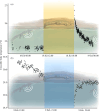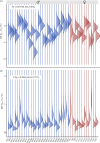Cooling down is as important as warming up for a large-bodied tropical reptile
- PMID: 39500376
- PMCID: PMC11537756
- DOI: 10.1098/rspb.2024.1804
Cooling down is as important as warming up for a large-bodied tropical reptile
Abstract
An ectotherm's performance and physiological function are strongly tied to environmental temperature, and many ectotherms thermoregulate behaviourally to reach optimum body temperatures. Tropical ectotherms are already living in environments matching their thermal tolerance range and may be expected to conform to environmental temperatures. We tracked the body temperatures (Tb) of 163 estuarine crocodiles across 13 years and compared Tb of 39 crocodiles to water temperature gathered using fish-borne sensors (Tw) across 3 years (2015-2018). While Tb largely conformed closely to Tw, we found inter- and intra-individual differences in relative body temperature (Tb-Tw) that depended on sex and body size as well as the time of day and year. Deviations from Tw, especially during the warm parts of the year, suggest that thermoregulatory behaviour was taking place: we found patterns of warming and cooling events that seemed to mediate this variation in Tb. Thermoregulatory behaviour was observed most frequently in larger individuals, with warming events common during winter and cooling events common during summer. By observing free-ranging animals across multiple years, we found that estuarine crocodiles show yearly patterns of active cooling and warming behaviours that modify their body temperature, highlighting their resilience in the face of recent climate warming. Our work also provides the first evidence for thermal type in large-bodied reptiles.
Keywords: acoustic telemetry; basking; intra-individual variation; thermal type; thermoregulation.
Conflict of interest statement
We declare we have no competing interests.
Figures






References
-
- Kondo J, Downes SJ. 2007. Does social behaviour reliably reflect temperature-dependent physiological capacity in geckos? Anim. Behav. 74, 873–880. (10.1016/j.anbehav.2006.10.030) - DOI
-
- Angilletta MJ Jr, Hill T, Robson MA. 2002. Is physiological performance optimized by thermoregulatory behavior?: a case study of the eastern fence lizard, Sceloporus undulatus. J. Therm. Biol. 27, 199–204. (10.1016/S0306-4565(01)00084-5) - DOI
-
- Seebacher F, Grigg GC. 1997. Patterns of body temperature in wild freshwater crocodiles, crocodylus johnstoni: thermoregulation versus thermoconformity, seasonal acclimatization, and the effect of social interactions. Copeia 1997, 549. (10.2307/1447558) - DOI
-
- Avery R, Meek R. 2008. Basking in the Australian water dragon physignathus lesueurii; why do alpha males not respond to operative temperatures in the same way as adults and sub-adults? Amphib-reptil. 29, 257–262. (10.1163/156853808784125009) - DOI
-
- Downs CT, Greaver C, Taylor R. 2008. Body temperature and basking behaviour of Nile crocodiles (Crocodylus niloticus) during winter. J. Therm. Biol. 33, 185–192. (10.1016/j.jtherbio.2008.02.001) - DOI
MeSH terms
Grants and funding
LinkOut - more resources
Full Text Sources
